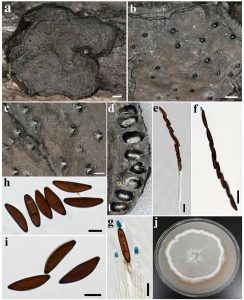Kretzschmaria hedjaroudei Pourmoghaddam & Khodap, in Pourmoghaddam, Khodaparast, Krisai-Greilhuber, Voglmayr & Stadler, Mycosphere 9(6): 1202 (2018)
Index Fungorum number: IF 827993, MycoBank number: MB 827993, Facesoffungi number: FoF 04958
Etymology – In honor of the Iranian mycologist Ghorban Ali Hedjaroude, a pioneer in the exploration of Iranian fungi.
Sexual morph: Stromata superficial, pulvinate, discrete, sessile, up to 2 cm long × 1–1.4 cm wide × 2.28–2.54 mm thick, attachment to substrate with strong connective, steep margins; surface black to dark brown, with inconspicuous perithecial mounds and cracks, carbonaceous immediately beneath surface; tissue between and beneath perithecia black to dark brown. Perithecia obovoid to cylindrical, 0.75–1.15 mm wide × 1.15–1.8 mm high, ostioles coarsely papillate. Asci with amyloid, urn-shaped apical apparatus, 6–8 μm high × 3–5 μm wide, stipe up to 200 μm long, spore-bearing part 90–140 × 12–14 μm. Ascospores smooth, unicellular, brown to dark brown, fusoid to ellipsoid, inequilateral, with narrowly or broadly rounded ends, 24–30 × 5–7 μm, with straight germ slit much less than spore-length on flattened side; perispore indehiscent in 10% KOH. Asexual morph: not produced in culture.
Culture characters – Cultures on 2% OA reaching 90 mm diam. in 4 weeks, first whitish, felty, and zonate, then becoming gray from the center outwards with concentric zones.
Holotype – Iran, Mazandaran Province, Tonekabon County, Dohezar forest, on wood or bark of a dead branch, N 36°47ʹ21.02”, E 50° 52ʹ34.07”, 1 m elev., 28 Oct 2016; M.J. Pourmoghaddam (GUM1549, consisting of a dried specimen). Ex-type cultures IRAN 3061C & STMA 18005.
GenBank accession numbers – ITS: MH084757, ACT: MH056204
Host – on wood or bark of a dead branch
Known distribution – Iran
Notes – Kretzschmaria hedjaroudei is closely related to K. deusta; however, it can be easily distinguished by its stromatal shape, smaller diameter and steep margins of stromata, coarsely papillate ostioles, smaller ascospores (24–30 × 5–7 vs. 27–35 × 7–9 μm), and larger apical apparatus (6–8 × 3–5 vs. 4–6 × 3–4 μm) (Rogers & Ju 1998). It is also similar to K. parvistroma according to the shape of the stromata, which, according to Mugambi et al. (2009), differs by much larger ascospores (34–)37–38(–39) × (10–)12–13 μm.
Fig. Kretzschmaria hedjaroudei (Holotype). a Stromata habit. b Close-up view of stromata surface. c Close-up view of ostiolar discs. d Stroma in vertical section showing perithecia. e Asci. f Asci, showing apical apparatus in Melzer’s reagent. g Apical apparatus in Melzer’s reagent. h–i Ascospores in water, showing germ slits. j Culture on OA. Scale bars: a = 1 mm, b = 0.4 mm, c = 0.2 mm, d = 0.5 mm, e–f = 20 μm, g–i = 10 μm.

